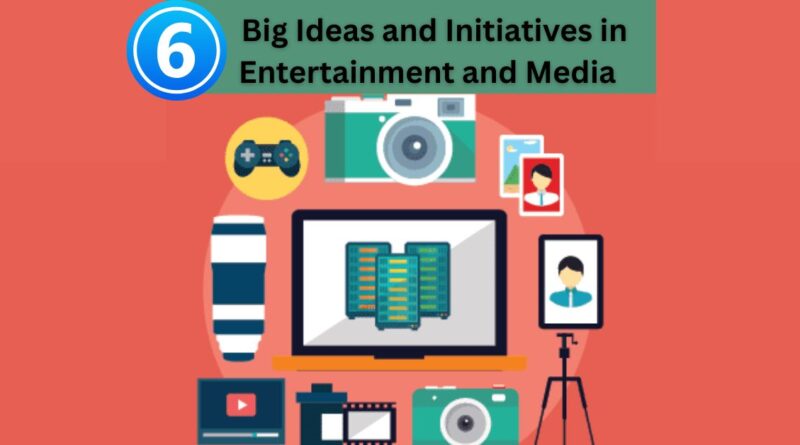6 Transformative Trends Shaping Entertainment and Media in 2025
The entertainment and media (M&E) industry in 2025 is experiencing a transformative shift driven by technology, evolving consumer habits, and innovative business models. From AI-powered personalization to immersive experiences, the sector is pushing boundaries and creating new ways to connect with audiences. Here are six of the biggest ideas and initiatives shaping the future of entertainment and media.
1. Advertising Renaissance and Business Model Reinvention
Advertising is becoming the primary driver of revenue growth in the M&E sector. Reports suggest that advertising could account for more than half of the industry’s growth in the next five years. Digital innovations such as connected TV ads, influencer marketing, and shoppable content are making advertising more targeted and interactive. Hybrid subscription models are also becoming common, with ad-supported tiers allowing audiences to access content at a lower cost in exchange for ad exposure.
For example, Disney+ has significantly grown its ad-supported subscription base in North America. In addition to these strategies, companies are restructuring through mergers and acquisitions to consolidate content libraries and streamline operations. This is particularly evident in markets like India, where regional and language-specific streaming platforms are consolidating to compete with global giants.
2. AI-Powered Personalization and Operational Reinvention
Artificial Intelligence has moved from being an experimental tool to becoming a core part of the M&E ecosystem. Companies are leveraging AI for personalized recommendations, real-time audience engagement, automated content tagging, localization, and marketing optimization. Disney has even created an “Office of Technology Enablement” to explore AI applications responsibly. While the potential is massive, studios are careful about AI investment, often limiting it to a small fraction of production budgets due to concerns about intellectual property, liability, and creative integrity. In live entertainment, AI is being used to enhance fan experiences through predictive analytics, dynamic pricing, and personalized offers, as seen in high-profile tours like Taylor Swift’s.
3. Immersion, Story-Living, and Multi-Sensory Experiences
Entertainment is moving beyond traditional storytelling toward “story-living,” where audiences actively participate in immersive and multi-sensory experiences. Technologies such as projection mapping, augmented and virtual reality, interactive audio, and even scent dispersion are becoming integral to attractions in theme parks, museums, retail spaces, and hospitality venues. These environments are increasingly context-aware, adapting in real time to audience behavior and preferences. Large-scale projects in regions like Saudi Arabia, including Qiddiya and New Murabba, are setting new global benchmarks by combining cutting-edge technology, cultural elements, and personalized visitor experiences.
4. Creator and Fan Economy: Direct Support and Niche Engagement
The rise of the creator economy is enabling content makers to build strong, direct connections with their audiences. Platforms like Patreon allow fans to financially support creators in exchange for exclusive content and perks. Some creators earn substantial monthly incomes by catering to highly engaged niche communities. The podcast industry is another major player in this space, with millions of active shows and significant corporate investments in high-profile content deals. This shift empowers creators to bypass traditional distribution channels and monetize their work directly, fostering deeper audience loyalty.

5. Gaming and Cloud Ecosystems: Powering Growth and Interactivity
Gaming has emerged as one of the most profitable sectors in the entertainment world, with revenue expected to surpass $300 billion by the end of the decade. Social and casual games dominate market share, while in-game advertising is rapidly expanding. Cloud gaming platforms such as Nvidia GeForce Now, Xbox Game Pass, and PlayStation’s streaming services are breaking hardware barriers, allowing players to access high-quality games without expensive consoles or PCs. Collaborations between gaming companies and entertainment giants are becoming more frequent, such as the integration of Fortnite with popular franchises like Marvel and Star Wars, blending interactive gameplay with storytelling.
6. Bundling, Consolidation, and Omnichannel Convenience
As consumers grow weary of managing multiple subscriptions, bundling has become a key strategy for content providers. Media companies are packaging their services with others to offer more value, such as Disney bundling Disney+, Hulu, and ESPN+. Telecom providers are also integrating internet and entertainment services into a single offering. Mergers and acquisitions continue to reshape the market, allowing companies to refine their content offerings and reduce operational costs. In live sports and events, omnichannel strategies combining in-person and digital engagement are enhancing the fan experience with real-time offers, mobile ticketing, and interactive venue features powered by high-speed connectivity.
Conclusion
The six major ideas and initiatives advertising reinvention, AI-powered personalization, immersive experiences, creator economies, gaming expansion, and bundling strategies are redefining the entertainment and media industry. The future points toward more personalized, interactive, and accessible entertainment ecosystems that blend storytelling, technology, and audience participation. Companies that adapt quickly and responsibly to these shifts will lead the next era of global entertainment.
FAQs
1. What is the biggest growth driver in the entertainment and media industry right now?
Advertising, particularly digital and targeted advertising, is the primary growth driver, with hybrid ad-supported subscription models becoming more popular.
2. How is AI being used in entertainment and media?
AI is used for content personalization, automated tagging, audience analytics, real-time recommendations, localization, and enhancing live event experiences through dynamic pricing and predictive insights.
3. What does “story-living” mean in the context of entertainment?
Story-living refers to immersive entertainment experiences where audiences actively participate in multi-sensory, interactive environments rather than just passively consuming content.
4. How are creators making money directly from fans?
Creators use platforms like Patreon and subscription-based services to earn from fan support, offering exclusive content, early access, and other perks in return.
5. Why is cloud gaming gaining popularity?
Cloud gaming allows players to stream high-quality games without expensive consoles or PCs, making it more accessible and affordable for a global audience.
6. What is driving the trend toward bundling in entertainment services?
Bundling offers convenience and value by combining multiple subscriptions or services into a single package, helping to reduce costs and simplify access for consumers.




